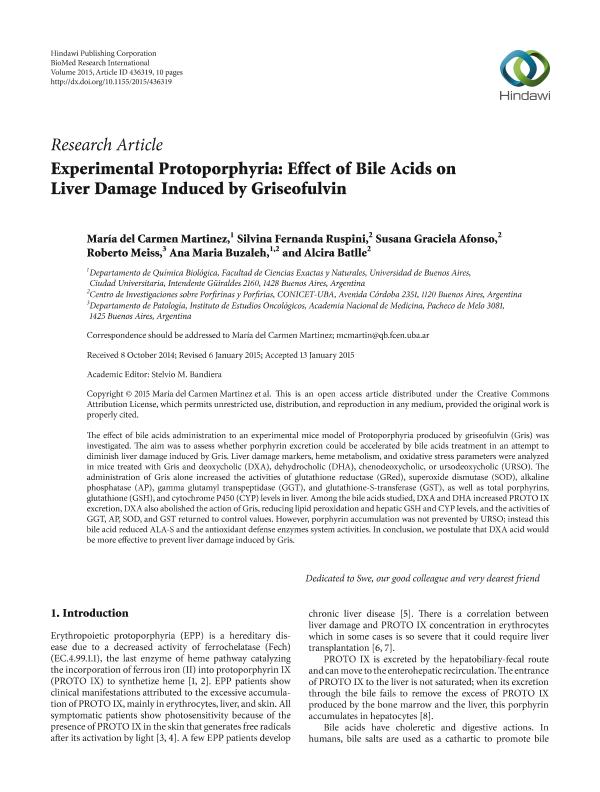Artículo
Experimental Protoporphyria: Effect of bile acids on liver damage induced by griseofulvin
Martinez, Maria del Carmen; Ruspini, Silvina Fernanda ; Afonso, Susana Graciela; Meiss, Roberto; Buzaleh, Ana Maria
; Afonso, Susana Graciela; Meiss, Roberto; Buzaleh, Ana Maria ; Batlle, Alcira Maria del C.
; Batlle, Alcira Maria del C.
 ; Afonso, Susana Graciela; Meiss, Roberto; Buzaleh, Ana Maria
; Afonso, Susana Graciela; Meiss, Roberto; Buzaleh, Ana Maria ; Batlle, Alcira Maria del C.
; Batlle, Alcira Maria del C.
Fecha de publicación:
01/2015
Editorial:
Hindawi Publishing Corporation
Revista:
BioMed Research International
ISSN:
2314-6133
Idioma:
Inglés
Tipo de recurso:
Artículo publicado
Clasificación temática:
Resumen
The effect of bile acids administration to an experimental mice model of Protoporphyria produced by griseofulvin (Gris) was investigated. The aim was to assess whether porphyrin excretion could be accelerated by bile acids treatment in an attempt to diminish liver damage induced by Gris. Liver damage markers, heme metabolism, and oxidative stress parameters were analyzed in mice treated with Gris and deoxycholic (DXA), dehydrocholic (DHA), chenodeoxycholic, or ursodeoxycholic (URSO). The administration of Gris alone increased the activities of glutathione reductase (GRed), superoxide dismutase (SOD), alkaline phosphatase (AP), gamma glutamyl transpeptidase (GGT), and glutathione-S-transferase (GST), as well as total porphyrins, glutathione (GSH), and cytochrome P450 (CYP) levels in liver. Among the bile acids studied, DXA and DHA increased PROTO IX excretion, DXA also abolished the action of Gris, reducing lipid peroxidation and hepatic GSH and CYP levels, and the activities of GGT, AP, SOD, and GST returned to control values. However, porphyrin accumulation was not prevented by URSO; instead this bile acid reduced ALA-S and the antioxidant defense enzymes system activities. In conclusion, we postulate that DXA acid would be more effective to prevent liver damage induced by Gris.
Palabras clave:
Bile Acids
,
Eritropoyetic Protoporphyria
,
Oxidative Stress
,
Griseofulvine
Archivos asociados
Licencia
Identificadores
Colecciones
Articulos(CIPYP)
Articulos de CENTRO DE INVEST. SOBRE PORFIRINAS Y PORFIRIAS
Articulos de CENTRO DE INVEST. SOBRE PORFIRINAS Y PORFIRIAS
Citación
Martinez, Maria del Carmen; Ruspini, Silvina Fernanda; Afonso, Susana Graciela; Meiss, Roberto; Buzaleh, Ana Maria; et al.; Experimental Protoporphyria: Effect of bile acids on liver damage induced by griseofulvin; Hindawi Publishing Corporation; BioMed Research International; 2015; 1-2015; 1-10
Compartir
Altmétricas



